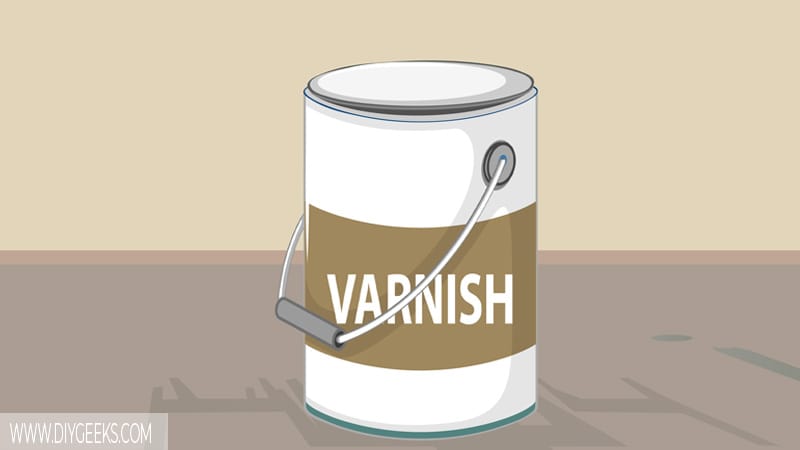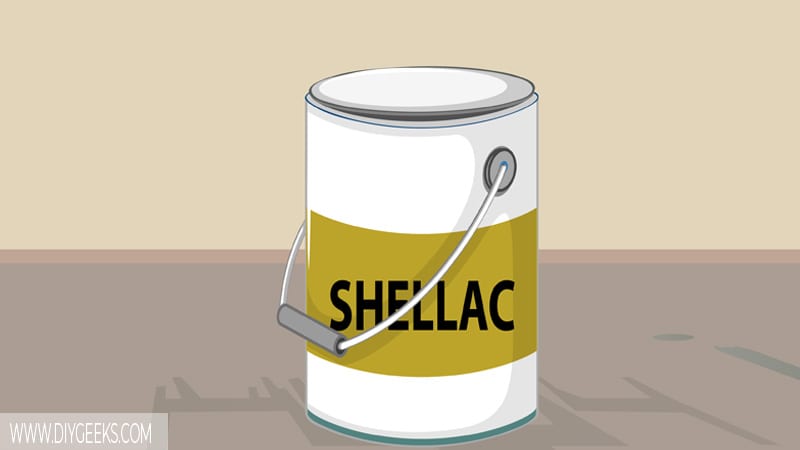Varnish is a protective coating that creates a moisture-resistant layer over surfaces. Shellac is a natural finish that enhances the surface appearance and offers low protection.
Varnish offers better wood protection, moisture resistance, and durability than shellac. Shellac dries faster, enhances the surface appearance better, and is easier to apply than varnish.
What is Varnish?

Varnish is a traditional sealer that creates a glossy moisture-resistant layer and protects surfaces from water, moisture, scratches, and weather elements.
There are different varnish types including acrylic, exterior, or spar varnish. Each type has a unique feature, but all types create a protective layer (barrier) over surfaces.
Varnish is a topical finish that doesn’t penetrate surface pores (or grain) to adhere — the sealer stays over the surface top layer and creates a glossy moisture-resistant layer over it.
What is Shellac Coating?

Shellac is a natural protective finish that enhances the surface appearance and offers low protection. It’s derived from shellac (a natural resin) that is obtained from lac bug (“Kerria lacca”) secretions found in southeast Asia.
Shellac is a traditional finish used historically in woodworking because of its ease of application and fast dry time.
Shellac is mixed with alcohol which creates a liquid solution that can be applied with a paintbrush, roller, or sprayer. Once applied, the alcohol evaporates from the surface, leaving behind a thin shellac layer that enhances the surface appearance.
It creates a rich amber-like finish that highlights the surface patterns, texture, and grain.
Varnish vs Shellac
The differences between varnish and shellac are listed below.
The Formula
The varnish formula contains synthetic resins, solvents, oils, and protective additives that create a hard and durable finish that protects surfaces.
Shellac contains a natural formula that is derived from shellac (a natural resin) and then mixed with alcohol before applying it. After applying shellac, the alcohol evaporates from the coating and leaves a thin protective layer over the surface.
Wood Protection
Varnish offers better wood protection than shellac as it’s formulated with more protective additives that create a hard (rigid) and moisture-resistant layer.
Shellac offers low wood protection and isn’t suited for surfaces that are exposed to high water amounts.
Moisture Resistance
Varnish has better moisture resistance than shellac as it forms a glossy moisture-resistant layer that prevents water penetration.
Shellac creates a low moisture-resistant finish that prevents low water amount penetration, but its finish will get removed if exposed to constant water.
Durability
Varnish lasts longer than shellac as it’s formulated with more protective additives that create a hard (rigid) and durable finish.
Shellac lasts long over interior surfaces that aren’t exposed to high traffic or constant water.
Purpose and Usage
Varnish is used to protect and seal stained or painted surfaces from moisture, water, or scratches. Shellac is used to enhance the wood appearance by creating a rich amber-like finish and offering low moisture resistance.
Price Tag
Shellac costs more than varnish as it’s a natural finish that is harder to make.
Viscosity
Varnish has a thicker viscosity than shellac as it’s formulated with more additives that make its flow thicker.
Shellac is lighter as it’s mixed with alcohol before applying.
Application
Varnish is harder to apply than shellac as it has a thicker viscosity that is harder to control and prevent drips. Since varnish has a thick viscosity, it can leave brush marks or imperfections once it dries.
Shellac is easier to apply as it doesn’t have a thick viscosity and dries fast, so you can apply multiple coats faster.
Interior or Exterior Use
You can use varnish for interior and exterior surfaces, but the sealer is more suited for exterior surfaces exposed to weather elements.
You can use shellac for interior surfaces only as it offers low surface protection compared to other exterior sealers.
Do You Need Varnish or Shellac?
Before choosing a wood finish, consider the following things.
- Budget: Use varnish if you have a low budget as it costs less than shellac.
- Protection: Use varnish if you want better wood protection from moisture, water, or scratches.
- Surface Type: Use shellac for interior surfaces, and varnish for exterior surfaces.
- Color: Use shellac if you want a rich amber-like finish that highlights the wood texture and patterns.


